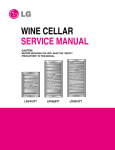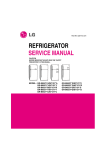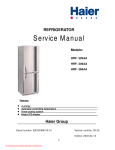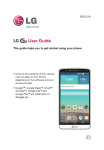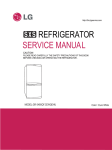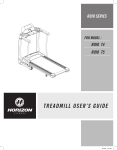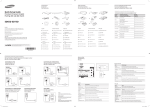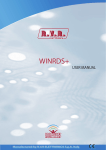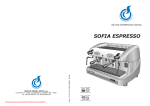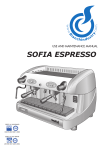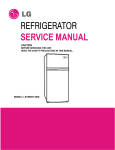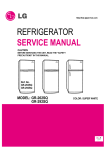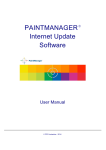Download WINE CELLER SERVICE MANUAL
Transcript
WINE CELLER SERVICE MANUAL CAUTION BEFORE SERVICING THE UNIT, READ THE "SAFETY PRECAUTIONS" IN THIS MANUAL. GC-W061*** GC-W101*** GC-W141*** TABLE OF CONTENTS 1. Product Specification.................................................................................................................................... 4 2. Component Names and Motions.................................................................................................................. 5 3. Exterior .......................................................................................................................................................... 8 4. Circuit Diagram ......................................................................................................................................... 13 5. TROBLESHOOTING......................................................................................................................................15 6. Micom Function and Circuit Diagram ..................................................................................................... 21 7. Special Features ....................................................................................................................................... 37 8. Standard Self-Diagnostic Function............................................................................................................ 38 9. Maintenance ................................................................................................................................................. 39 10. Handle Disassembling, Assembling Instruction .................................................................................... 42 11. Service Parts Chart ................................................................................................................................... 43 SAFETY INSTRUCTIONS Please read the following instructions before servicing your 7. When tilting the set, remove any materials on the set, especially the thin plates(ex. Glass shelf or books.) refrigerator. 8. Leave the disassembly of the refrigerating cycle to a specialized service center. The gas inside the circuit may pollute the environment. 1. Check the set for electric losses. 2. Unplug prior to servicing to prevent electric shock. 3. Whenever testing with power on, wear rubber gloves to prevent electric shock. 9. When you discharge the refrigerant, wear the protective safety glasses or goggle for eye safety. 4. If you use any kind of appliance, check regular current, voltage and capacity. 10. When you repair the cycle system in refrigerator, the work area is well ventilated. Especially if the refrigerant is R600a, there are no fire or heat sources. (No smoking) 5. Don't touch deep-frozen products in the freezer with wet hands. This may cause frostbite. 6. Prevent water from following onto electric elements in the mechanical parts. -2- SERVICING PRECAUTIONS Features of refrigerant (R600a) After the refrigerant (R600a) is completely discharged, repair any defective parts and replace the dryer. At any case you must use the LOKRING for connecting or replacing any part in the cycle (No Fire, No Welding). Connect the Schrader valve to pump with the coupler. And then turn the pump on for vacuum state (Figure 3). Let the pump run until the low-pressure gauge indicates the vacuum (gauge pressure 0, absolute pressure -1atm or -760mmHg). Recommended vacuum time is 30 min. Charge the N2 gas in order to check for leakage from welding points and the LOKRING. If leakages are found, repair the defects and repeat the vacuum process. • Achromatic and odor less gas. • Flammable gas and the ignition (explosion) at 494°C. • Upper/lower explosion limit: 1.8%~8.4%/Vol. Features of the R600a refrigerator • Charging of 60% refrigerant compared with a R134a model • The suction pressure is below 1bar (abs) during the operation. • Because of its low suction pressure, the external air may flow in the cycle system when the refrigerant leak, and it causes malfunction in the compressor. • The displacement of compressor using R600a must be at least 1.7 times larger than that of R134a. • Drier type is XH-9. • The EVAPORATOR or any other cycle part that has welding joint is hidden in the foam. (If not hidden inside, the whole electric parts must be tested with the LEAKAGE TEST according to the IEC Standard.) • The compressor has label of the refrigerant R600a. • Only the Service man must have an access to the system. TO THE VACUUM PUMP PRESSURE GAUGE Figure 3 After the system is completely vacuumed, fill it with the refrigerant R600a up to what has been specified at your refrigerator Name Plate. The amount of refrigerant (R600a) must be precisely measured within the error of ±1g by an electron scale (Figure 4). If you use the manifold connected with both the refrigerant (R600a) cylinder and the vacuum pump simultaneously, make sure the pump valve is closed (Figure 5). Installation place • Must be well ventilated. • Must be 20 m3 or larger. • Must be no-smoking area. • No ignitable factors must be present. Utilities • Refrigerant cylinder (MAX NET 300g) • Manometer • Vacuum pump (600L/min) • Piercing Clamp • Quick coupler • Hoses (5m-1EA, 1m-3EA) • LOKRING • Portable Leakage detector (3g/year¯) • Nitrogen cylinder (for leakage test) • Concentration gauge REFRIGERANT (R600a) CHARGING HOSE COUPLE THROTTLE VALVE WEIGH SCALE Figure 4 Make sure before Servicing • Refrigerant Confirm the refrigerant by checking Name Plate on innerliner and the label on the compressor. • If the refrigerant is R600a, you must not weld or apply a heat source. FILLING OR CHARGE TUBE TO THE REFRIGERATION SYSTEM Air Recharging in Compressor Before refilling the refrigerant, you must perform the test according to Chapter 5 (TROUBLESHOOTING CHART). When the defects are found, you must discharge the residual refrigerant (R600a) in the outdoor. For discharging the refrigerant R600a, break the narrow portion of tube extension by hand or with a pipe cutter as shown in Figure 1. Leave it for 30min in outside to stabilize the pressure with ambient. Then, check the pressure by piercing the dryer part with piercing pliers. If the refrigerant is not completely discharged, let the refrigerator alone for more 30min in outside. POINT TO BE BROKEN SERVICE TUBE EXTENSION Figure 1 VALVE TO BE OPENED WHEN REFILLING TO THE CHARGE CYLINDER VALVE TO BE CLOSED AFTER VACUUM TO THE VACUUM PUMP Figure 5 Connect the charging hose (that is connected to the refrigerant (R600a) cylinder) to the Schrader valve installed on the service tube. Then, charge the refrigerant (R600a) by controlling the Throttle valve. When you do so, do not fully open the Throttle valve because it may make damage to the compressor. Gradually charge the refrigerant (R600a) by changing open and close the Throttle Valve (5g at each time). The charging hose must use a one-way valve to prevent the refrigerant refluence. Close the Schrader valve cap after the refrigerant (R600a) is completely recharged. After you completely recharge the refrigerant (R600a), perform the leakage test by using a portable leakage detector or soapy water. Test the low pressure (suction) parts in compressor off time and high pressure parts in compressor on time. If the leakages are found, restart from the refrigerant (R600a) discharging process and repairs defects of leaks. After the leakage test, check the temperature of each parts of the cycle. Check with hands if the CONDENSER and the case (HOT-LINE pipe) that is contacted to the door gasket are warm. Confirm that frost is uniform distributed on the surface of the freezer room and the back wall of fridge room. CHARGE TUBE EXTENSION SCHRADER VALVE (ONE-WAY VALVE) LOKRING Figure 2 Attach the service tube installed with a Schrader valve (one-way valve) by using the LOKRING (Figure 2). Then, connect the Schrader valve (one-way valve) to the pump that is connected to the discharging hose leading to the outside. When discharging the residual refrigerant, repeat 3 cycle that includes 3min of the pump running->pump off->30sec of the compressor running. -3- PRODUCT SPECIFICATION 1. Product Specification 1-1. Rated, product specifications Model Name Regular Contents Exterior measurements (Width X Depth X Height) GC-W061*** GC-W101*** GC-W141*** 135Li 214Li 283Li 595 X 580 X 820 595 X 580 X 1185 595 X 580 X 1475 Rated Voltage/Frequency 230V / 50Hz Power Consumption 72W 80W 85W Weight 47kg 64kg 71kg Cooling Method Cool Air Automatic Circulation Type Temperature Control Device MICOM Outer Case Material Vynil Coated Metal Inner Case Material A.B.S Resin OUT DOOR Indium Thin Oregan Triple Layers Glasses/Aluminium Deco Insulation Material Poly Urethane Foam (Insulation Foam Gas: Cyclopentane) Package Exterior Package Measurement Details (Width X Depth X Height) Package Weight 693 X 717 X 946 693 X 717 X 1296 693 X 717 X 1586 51kg 74kg 81kg GC-W061*** GC-W101*** GC-W141*** 1-2. Component Details Model Name Compressor MB69NAEG MB98NBEG Overload Protect 4TM149NFB 4TM205RFB P.T.C P330MC P330MC Heater UPPER: 8W (1EA) UPPER: 4W (2EA) UPPER: 8W (2EA) UPPER: 5W (2EA) Interior Light 12V / 3W / 0.25A Power Cord (Length) 1.9m Temperature Sensor Heat Reducing Load Resistance Device • Interior Heater: Heat up the interior when surrounding temperature is lower than the set temperature. -4- COMPONENT NAMES AND MOTIONS 2. Component Names and Motions 2-1. Interior • Interior Light (Interior Ceiling, CASE DISPLAY & BARRIER installed in the lower column) Interior light operates by the control panel regardless of door opening or closing. • Interior light uses DC voltage. Please see 1-2, component details. • 2 or 3 interior lights are installed according to model sizes and light turns on and off by control panel operation button. 2-2. Wine Rack • Wine rack detail may vary according to the model types. • Each rack can hold 8 wine bottles and top rack holds 9 bottles. Model Name GC-W061*** GC-W101*** GC-W141*** Standard Capacity 41bottles 65bottles 81bottles 2-3 Others • Glass Holder -Hangs wine glasses. (GC-W141***) • Wine Rack -Stores leftover wine (tilted). (GC-W141***, GC-W101***) • Locking Device -Key is enclosed in the inside of the refrigerator. • Leg Adjustor (Front & Back, Left & Right, one each) -Please level the product using the leg adjustor. -5- COMPONENT NAMES AND MOTIONS GC-W141*** *Glass tray Operation panel Light bulb • Light bulb inside the wine fridge can be turned on or off by pressing the button on the operation panel. • Light bulb inside the wine fridge will automatically turn off after the door is open for an hour. Wine shelf Top/Bottom Separation Panel • The partition is separated into 'Top' partition and 'Bottom' partition based on the top/bottom separation panel. Temperature is adjusted with 'Top' button and 'Bottom' button respectively. Adjustable support Can be adjusted when the fridge is not stable. -6- COMPONENT NAMES AND MOTIONS GC-W101*** Operation panel Light bulb • Light bulb inside the wine fridge can be turned on or off by pressing the button on the operation panel. • Light bulb inside the wine fridge will automatically turn off after the door is open for an hour. Wine shelf Top/Bottom Separation Panel • The partition is separated into 'Top' partition and 'Bottom' partition based on the top/bottom separation panel. Temperature is adjusted with 'Top' button and 'Bottom' button respectively. Adjustable support Can be adjusted when the fridge is not stable. GC-W061*** Light bulb • Light bulb inside the wine fridge can be turned on or off by pressing the button on the operation panel. • Light bulb inside the wine fridge will automatically turn off after the door is open for an hour. Wine shelf Operation panel Adjustable support Can be adjusted when the fridge is not stable. -7- EXTERIOR 3. Exterior 3-1. Exterior GC-W061*** -8- EXTERIOR GC-W101*** -9- EXTERIOR - 10 - EXTERIOR GC-W141*** - 11 - EXTERIOR - 12 - CIRCUIT DIAGRAM 4. Circuit Diagram 4-1. Circuit Diagram : Indicated component is a safety part. (In case of a replacement, please use a designated part for its function and your safety.) GC-W061*** MODEL: GC-W061*** This product is powered by electricity. Once the power is plugged out, please wait at least 5 minutes before you plug it back in. If you plug the power right back in, it will cause a malfunction in the cooling machine. Temperature Indicator, Control Panel Power Plug Compressor Exterior Temperature Sensor Interior Temperature Sensor (Top) Cooling Sensor (Top) Interior Light Case Display Heater (Top) Control Panel Interior Light Heater (Bottom) BK : BLACK BL :BLUE BO : BROWN OAK BN :BROWN YL :YELLOW PR :PURPLE GY :GRAY WH : WHITE - 13 - CIRCUIT DIAGRAM GC-W101***/GC-W141*** - 14 - TROBLESHOOTING 5. Trobleshooting 5-1. COMPRESSOR AND ELECTRIC COMPONENTS 1 2 Power Source Check the resistance of the Compressor Motor. Separate the PTC-STARTER from the Compressor and measure the voltage between M and C of the Compressor. Equal to the applied voltage. (Rating voltage ± 10%) The applied voltage is not in the range of Rating Voltage ± 10%. Advice the customer to use in the specified range. 4 Test the resistance among M-C, S-C, and M-S. If not 0 or 3 YES 2 NO 3 Check the resistance of the PTC. Replace the Compressor. 3 Test the resistance of the both terminals in the PTC-STARTER. 4 Replace the PTC-STARTER. NO 4 Check OLP. Check if applying a regular OLP. 4 YES YES Advice the customer to use in the specified range. 5 NO Replace OLP. NO 5 Check the starting state. Measure minimum starting voltage after checking steps 1-3 above. Measure the pressure balance of the PTC at the interval of more than 5 min. Starts at the voltage of 85% below. Starts at the voltage of more than 90%. Check the starting state at the regular voltage above. Normal. YES Normal. NO Replace the PTC. - 15 - 5 5-2. PTC Poor starting or no operating of the Compressor. First, separate the PTC from the Compressor and check the voltage between NO 5 and 6 in the PTC with a multitester or Wheatstone Bridge. Observation value is 220~240V/50Hz : Normal Check another electric components. The value is 0. Abnormal Replace the PTC. Abnormal Replace the PTC. The value is YES Separate the OLP from the Compressor and check resistance value between two terminals of OLP with Tester. NO - 16 - . Check other electric components. Replace OLP. 5-3. ANOTHER ELECTRIC COMPONENTS 5-3-1. No Cooling The Compressor doesn't run. Check if the current flows at the contacting point of the Thermostat. Poor contacting point Replace the Thermostat. Check the current flowing of starting system. Shorted or Broken Replace the device. Check if the current flows at the main coil of the Comprossor. Coil shorted Replace the Compressor. Check the components on the main circuit. Poor running of the Compressor. Compressor runs. Replace the components. Measure the starting voltage. Low voltage Increase the voltage. Check if the current flows at the contacting point of the starting system. Shorted Poor contacting point and broken Replace the device. Frost doesn't form on the back wall of freezer and fridge room when operating set for more than 30 min. Refrigerant leaks. Poor compressing. Repair the Compressor. - 17 - 5-4. REFRIGERATING CYCLE 5-4-1. Troubleshooting chart DEFECT EFFECT CAUSE REMEDY Freezer and fridge room do not frost even though motorcompressor runs continually. An empty refrigerant system indicates a leakage of isobutane (R600a). This loss is generally to be looked for at the soldering points connecting the various components or in an eventual hole in the evaporator made by the user. Leakage must be eliminated by resoldering the defective point . EXCESSIVELY FULL This defect is indicated by the presence of water outside the refrigerator near the motor caused by formations of ice on the return tube. If in the refrigerant system a quantity of R600a is introduced which is greater than that indicated, the excess gas does not terminate its expansion in the evaporator but proceeds into the return tube. The system must be emptied and subsequently refilled introducing the correct quantity of R600a. HUMIDITY IN THE SYSTEM This defect is indicated by the partial frosting of the freezer room and by continual defrosting cycles determined by the interruption of the flow of gas on the evaporator. The motor compressor keeps running. The refrigerant system is humid when there is a small percentage of water present, which, not completely retained by the dehydrator filter, enters into circulation with isobutane and freezes at the capillary exit in the evaporator. The system must be emptied and then refilled after eliminating the humidity. PRESENCE OF AIR IN THE SYSTEM Poor performance of the refrigerant system which is indicated on the evaporator with a slight frost which does not freeze and an excessive overheating of the condenser and motor-compressor. There is air in the refrigerating system when during the filling phase vacuum is not effected or it is not adequately done. Group must be drained and subsequently refilled after carefully creating vacuum. Because of the lack of circulation isobutane in the system, there is no frosting of the evaporator, while a slight overheating of the first spiral of the condenser is noted. Impurities contained in isobutane or in the components of the refrigeration system before assembly and not retained by the filter can obstruct the capillary. Do away with the refrigerator. MOTORCOMPRESSOR DOSE NOT COMPRESS No frost forms on the evaporator, even if the motor-compressor is running. In this case there is a mechanical failure in the diaphram valves which remaining continually open, do not permit the compressor to operate. Consequentely, isobutane does not circulate in the system. The motor-comprossor must be replaced and then proceed with refilling. NOISY MOTORCOMPRESSOR In case of mechanical failure in the motor-compressor there in an excessive noise when the system is functioning. In case a suspension spring is unhooked, banging will be heard and there will be especially strong vibrations when the system starts up and stops. The cause of the excessive noise is normally to be sought for in a mechanical breakdown, and only rarely in the unhooking of one of the suspension springs. The motor-compressor must be replaced and then proceed with the refilling. SYSTEM PARTIALLY OR COMPLETELY OUT OF REFRIGERANT CHARGE BLOCKED CAPILLARY - 18 - 5-4-2. General Control of Refrigerating Cycle NO. ITEMS CONTENTS AND SPECIFICATIONS WELDING ROD (1) H 30 • Chemical Ingredients • Ag: 30%, Cu: 27%, Zn: 23%, Cd: 20% • Brazing Temperature: 710~840 °C (2) Bcup-2 • Chemical Ingredients • Cu: About 93% • P: 6.8~7.5% •The rest: within 0.2% • Brazing Temperature: 735~840 °C 1 FLUX 2 7 DRIER ASM (1) Assemble the drier within 30min. after unpacking. (2) Keep the unpacked drier at the temperature of 80~100 °C. • Don't keep the drier in a outdoors because humidity damages to it. VACUUM (1) When measuring with pirant Vacuum gauge the charging M/C, vacuum degree is within 1 Torr. (2) If the vacuum degree of the cycle inside is 10 Torr. below for low pressure and 20 Torr. for high pressure, it says no vacuum leakage state. (3) Vacuum degree of vacuum pump must be 0.05 Torr. below after 5 min. (4) Vacuum degree must be same to the value described item (2) above for more than 20 min. • Apply M/C Vacuum Gauge without fail. • Perform vacuum operation until a proper vacuum degree is built up. • If a proper vacuum degree isn't built up, check the leakage from the Cycle Pipe line part and • Quick Coupler Connecting part. DRY AND AIR NITROGEN GAS (1) The pressure of dry air must be more han 12~16kg/cm 2 (2) Temperature must be more than -20~-70 °C. (3) Keep the pressure at 12~6kg/cm 2 also when substituting dry air for Nitrogen Gas. NIPPLE AND COUPLER (1) Check if gas leaks with soapy water. (2) Replace Quick Coupler in case of leakage. PIPE 8 • Make amount for only day. Holding period: 1 day • Close the cover of container to prevent dust putting in the FLUX. • Keep it in a stainless steel container. (1) Both of the tube is inserted up to the stop. • For a hermetically sealed metal/metal (2) Both of the LOKRING is pushed up to the stop connection, the tube ends have to be clean. • LOKPREP is distributed all of out-surface of (3) The bending point is not too close to the the tube ends. joint ending. (4) During the assembly it is important that both ends remain completely within the joint. 5 6 • Recommend H34 containing 34% Ag in the Service Center. LOKRING (Figure 15,16) 3 4 • Ingredients and how to make Borax 30% Borax 35% Fluoridation kalium: 35% Water: 4% Mix the above ingredients and boil until they are transformed into liquid. REMARKS • Put all Joint Pipes in a clean box and cover tightly with the lid so that dust or humidity is not inserted. - 19 - • Check if gas leaks from joint of the Coupler. TUBE LOKRING LOKRING Figure 15. LOKRING ASSEMBLY JAWS BOLT TOOL Figure 16. LOKRING TOOL - 20 - JOINT MICOM FUNCTION AND CIRCUIT DIAGRAM 6. MICOM Function and Circuit diagram 6-1. Functions 6-1-1. Displays 1. At the first power-up, the machine is unlocked. And, the initial setting is 14°C/RED for top, 8°C/WHITE for bottom. 6-1-2. Lock/Unlock Function 1. By pressing the ‘Lock/Unlock’ button for 3 seconds, it will unlock the machine. If the control panel is idle for 10 second, it will automatically lock itself. 2. 1 minute after the lock, the luminosity of the display will decrease. 3. You have to cancel the lock in order to operate the machine. 6-1-3. Setting the top/bottom parts’ storage temperature (1) Top temperature setting 1. With the lock off, set the top storage temperature using ‘ 2. By pressing ‘ ’ button on the left side of the display. ’ It will display in the order of 6°C 3. By pressing ‘ ’, ‘ 11°C WHITE LED ON 12°C 12°C 11°C 18°C RED LED ON ’ It will display in the order of 18°C RED LED ON 6°C WHITE LED ON 4. NOTE: Top temperature cannot be lower than the bottom (2) Bottom temperature setting 1. With the lock off, set the top storage temperature using ‘ 2. By pressing ‘ ’ button on the right side of the display. ’ It will display in the order of 6°C 3. By pressing ‘ ’, ‘ 11°C WHITE LED ON 12°C 12°C 11°C 18°C RED LED ON ’ It will display in the order of 18°C RED LED ON 6°C WHITE LED ON 4. NOTE: Bottom temperature cannot be higher than the top. - 21 - MICOM FUNCTION AND CIRCUIT DIAGRAM 6-1-4. DISPLAY OFF Function 1. With the lock off, by pressing the ‘Power’ button for 3 seconds, every LED turns to OFF and the machine switches to suspension mode. 2. In the suspension mode, by pressing ‘Power’ button for 3 seconds, the suspension mode becomes cancelled and the Top/Bottom part displays its prior values. NOTE: The lock is off. You can change the Top/Bottom temperature. 6-1-5. Lamp ON/OFF Function 1. Each press of LAMP button turns on/off the LAMP. 2. If the LAMP remains turned on over an hour, the LAMP automatically turns itself off. 6-1-6. Temperature Control (1) Top Temperature 1. Top temperature is controlled by controlling the coolant intake valve according to the set temperature. 2. If the exterior temperature is lower than the top setting, the control increases the temperature by turning on/off the top heater. (2) Bottom Temperature 1. Bottom temperature is controlled by controlling the coolant intake valve according to the set temperature. 2. If the exterior temperature is lower than the bottom setting, the control increases the temperature by turning on/off the bottom heater. (3) 3-WAY Valve Operation Condition 1. Appropriate valve opens/closes according to the each sensor temperature. 2. If both top and bottom temperature is insufficient, The part that is already in cooling process finishes its cooling, then the other part’s valve becomes opened. (No simultaneous cooling) 3. If the cooling is not finished in given time (45min for top/30min for bottom), the parts valve in cooling process will be closed and the other part’s valve will be opened. Top Part Bottom Part Valve Operation Satisfied Satisfied 1)* Satisfied Unsatisfied Top CLOSE / Bottom OPEN Unsatisfied Satisfied Top CLOSE / Bottom OPEN Unsatisfied Unsatisfied Top 45min / Bottom 30min *1): The opposite valve of the last satisfied part will be opened. (4) COMP Operation Condition 1. COMP will be turned on if either of top or bottom part temperature is unsatisfied. NOTE: If EVA sensor reading is below the set temperature, COMP will not operate. 2. If both top and bottom are satisfied, COMP switches to OFF. 3. If bottom is satisfied and top is unsatisfied after a heating, COMP will not be turned on until 30 minutes after the heating termination. 4. If top is satisfied and bottom is unsatisfied after a heating, COMP will not be turned on until 30 minutes after the heating termination. - 22 - MICOM FUNCTION AND CIRCUIT DIAGRAM 6-1-7. Exterior Temperature Counter Operation 1. A sensor senses exterior temperature and keeps interior temperature constant. Wine Cellar Storage Temperature Normal Operation Exterior Temperature Counter Operation Seasons Spring Summer Fall Winter 6-1-8. Electronic Parts Consecutive Operation Electronic parts, such as COMP, top/bottom, will operate in consecutive order to prevent a noise and parts damages from multiple parts operating at an initial power-on and a series of test runs. (Includes temporary power outrage) Function Load Operation Order POWER ON Instantly Top Heater ON 3seconds Top Heater OFF 0.5seconds VALVE Opening 3minutes Bottom Heater ON 3seconds Bottom Heater OFF COMP ON At an initial Power-on 3seconds Top VALVE OPEN 10seconds All loads OFF 7minutes COMP ON Recovering from the TEST MODE 3seconds VALVE Opening - 23 - 3minutes Left VALVE OPEN MICOM FUNCTION AND CIRCUIT DIAGRAM 6-1-9. Malfunction Diagnosis Function 1. This function is to facilitate SVC at a time of a problem during an operation. 2. Even when a problem occurs, display buttons and LED will operate in normal condition. You can identify the problem by pressing both ‘ ’ and ‘ ’ button. The display will indicate the problem for 5 seconds. NOTE: In case of a communication error, the problem will automatically be displayed on the bottom temperature setting LED. 3. For every sensor malfunction (top, top EVA, bottom, bottom EV, Exterior sensor), all of the appropriate malfunction indications will be displayed even when more than 2 sensors are malfunctioning. 4. In case of a communication error, the communication error has the priority. Sensor malfunction indication will not be displayed during a communication error display. 5. Sensor malfunctions and communication error indications NO Malfunctions Conditions A part B part C part D part E part 1 Top sensor malfunction 8 E ON 8 8 Cut wire or short circuit in top sensor 2 Top EVA sensor malfunction E 8 ON 8 8 Cut wire or short circuit in top EVA sensor 3 Bottom sensor malfunction 8 8 ON 8 E Cut wire or short circuit in a bottom sensor 4 Bottom EVA sensor malfunction 8 8 ON E 8 Cut wire or short circuit in a bottom EVA sensor 5 Exterior sensor malfunction 8 8 OFF 8 8 Cut wire or short circuit in an exterior sensor 6 Communication malfunction OFF OFF OFF C O No communication in 30 consecutive seconds (connector unplugged, defected TR in communication part) 6-1-10. TEST Function 1. Test function allows PCB and product function check, and malfunctioning part identification. 2. TEST S/W is on the MAIN PCB. Test mode resumes normal operation after 2 hours. 3. After you terminate the test mode, you have to unplug the power in order to resume the normal mode. MODE Operation COMP VALVE DISPLAY LED TEST1 Press TEST S/W once ON Top valve OPEN P1 Checking for top part’s cooling system TEST2 Press TEST S/W once from TEST1 ON Bottom valve OPEN P2 Checking for bottom part’s cooling system TEST3 Press TEST S/W once from TEST2 ON TOP 45min / Bottom 15min switchover P3 Checking for top/bottom part’s cooling system Resume Each test mode resumes the initial state after two hours Normal Operation When resuming from the test mode, operation will activate after 5 minutes COMP delay - 24 - MICOM FUNCTION AND CIRCUIT DIAGRAM 6-2. Circuit Diagram 6-2-1. Power Supply Diagram 28 (VAREF) 14 3 (VASS) Power supply diagram consists of a noise reduction part and a SIMPS(Switching Mode Power Supply), a rectifying part (BD1, CE1) (from AC to DC), a switching part (IC3) for switching the DC voltage, TRANS for delivering the energy from Switch 1 to #2, Switch #2 for supplying power to MICOM and IC, and a FEED BACK(IC4) for sending a feedback to TRANS in order to maintain a consistent voltage at #2. Caution There may be high voltage electricity (DC310V) on the power supply. Please wait more than 3 minutes after you unplug the power in order to prevent an electric shock. 6-2-2. Oscillation Circuit Synchronizing CLOCK generation for transmitting and receiving information of IC1 (MICOM) inner logic devices, and time generation for time calculation. If specifications of OSC1 are modified, it may alter its calculation time or may cause a malfunction. Please use regular parts. 2 R31 1 6-2-3. RESET Circuit When MICOM is powering up from an initial power-on or from a power outrage recovery, the reset circuit initialize several parts inside of the MICOM (C1), including the RAM. In the early stage of the power-up process, the MICOM RESET terminal is supplied with a ‘LOW’ voltage for a certain period of time (10mins). (normal voltage for RESET terminal is 5.3V) (MICOM does not operate with a defected RESET IC) R1 IC3 1 CC13 KIA7042AP 2 27 3 CC104 - 25 - MICOM FUNCTION AND CIRCUIT DIAGRAM 6-2-4. Load Drive Circuit Load Type COMP Top Maturing Heater Bottom Maturing Heater Measuring Parts (IC2) #15 #13 #14 Condition ON Below 1V OFF 12V 6-2-5. STEPPING MOTOR Operation Circuit (3-WAY VALVE) CON6 IC6 R14 R15 R16 R17 16 15 18 17 R41 P40 P43 P42 According to a specified STEP numbers, send ‘HIGH’ and ‘LOW’ signals through MICOM PIN #16, 15, 18, and 17. Revolving magnetism forms on the motor coil. Motor starts running. - 26 - MICOM FUNCTION AND CIRCUIT DIAGRAM 6-2-6. Switch Input Circuit R18 P11 20 Input Circuit is to sense a TEST-S/W signal for refrigerator inspection. 6-2-7. Temperature Sensing Circuit This circuit consists of top/bottom sensor, top EVA/bottom EVA sensor for controlling top/bottom parts’ storage/maturing temperature, and an exterior temperature sensor. Each sensor’s SHORT and OPEN condition is as followed. Sensor Check Point Exterior Sensor POINT A Voltage Top Sensor POINT B Voltage Bottom Sensor POINT E Voltage Top EVA Sensor POINT C Voltage Bottom EVA Sensor POINT D Voltage Normal (-30 ~50 0.5 V~4.5 V - 27 - ) SHORT OPEN 0V 5V MICOM FUNCTION AND CIRCUIT DIAGRAM 6-2-8. Temperature compensation and overcooling / insufficient cooling, maturing temperature cut compensation circuit. (1)Temperature Compensation R2 P65 (AIN5) R3 9 UCR1 P66 10 (AIN6) LCR2 A circuit to input a value of compensation temperature to MICOM for controlling top/bottom storage temperature Top Bottom (RCT) (RCB) Value of temperature compensation Others 180 +2.5 ˚C 56 +2.0 ˚C Compensation to warm up 33 +1.5 ˚C 18 +1.0 ˚C 12 +0.5 ˚C 10 0 ˚C 8.2 -0.5 ˚C 5.6 -1.0 ˚C 3.3 -1.5 ˚C 2 -2.0 ˚C 470 -2.5 ˚C Standard Compensation to cool down 4 Temperature compensation chart according to a resistance value change (Value differences by current temperature) Ex) Top Resistance Compensation (RCT) 10K(Current Resistance) → 18K(Modified Resistance) = Top Temperature +1 ˚C Modified Classification CurrentResistance 470 2 3.3 5.6 8.2 10 12 18 33 56 180 Resistance Top (RCT) Bottom (RCB) 470 No Change 0.5 Increase 1 Increase 1.5 Increase 2 Increase 2.5 Increase 3 Increase 3.5 Increase 4 Increase 4.5 Increase 5 Increase 2 0.5 Decrease No Change 0.5 Increase 1 Increase 1.5 Increase 2 Increase 2.5 Increase 3 Increase 3.5 Increase 4 Increase 4.5 Increase 3.3 1 Decrease 0.5 Decrease No Change 0.5 Increase 1 Increase 1.5 Increase 2 Increase 2.5 Increase 3 Increase 3.5 Increase 4 Increase 5.6 1.5 Decrease 1 Decrease 0.5 Decrease No Change 0.5 Increase 1 Increase 1.5 Increase 2 Increase 2.5 Increase 3 Increase 3.5 Increase 8.2 2 Decrease 1.5 Decrease 1 Decrease 0.5 Decrease No Change 0.5 Increase 1 Increase 1.5 Increase 2 Increase 2.5 Increase 3 Increase 10 2.5 Decrease 2 Decrease 1.5 Decrease 1 Decrease 0.5 Decrease No Change 0.5 Increase 1 Increase 1.5 Increase 2 Increase 2.5 Increase 12 3 Decrease 2.5 Decrease 2 Decrease 1.5 Decrease 1 Decrease 0.5 Decrease No Change 0.5 Increase 1 Increase 1.5 Increase 2 Increase 18 3.5 Decrease 3 Decrease 2.5 Decrease 2 Decrease 1.5 Decrease 1 Decrease 0.5 Decrease No Change 0.5 Increase 1 Increase 1.5 Increase 33 4 Decrease 3.5 Decrease 3 Decrease 2.5 Decrease 2 Decrease 1.5 Decrease 1 Decrease 0.5 Decrease No Change 0.5 Increase 1 Increase 56 4.5 Decrease 4 Decrease 3.5 Decrease 3 Decrease 2.5 Decrease 2 Decrease 1.5 Decrease 1 Decrease 0.5 Decrease No Change 0.5 Increase 180 5 Decrease 4.5 Decrease 4 Decrease 3.5 Decrease 3 Decrease 2.5 Decrease 2 Decrease 1.5 Decrease 1 Decrease 0.5 Decrease No Change - 28 - MICOM FUNCTION AND CIRCUIT DIAGRAM 6-2-9. Communication Circuit between MAIN PCB and DISPLAY PCB Communication circuit for an information exchange between MAIN MICOM and DISPLAY PCB in MAIN PCB If there is an interruption in information exchange between MAIN MICOM and DISPLAY PCB in MAIN PCB for more than 30 seconds, it causes a communication malfunction. MAIN PCB DISPLAYPCB DC 12V LCD Controlling MICOM MAIN MICOM GND Transmitting (Error) Receiving (NOTCH) - 29 - MICOM FUNCTION AND CIRCUIT DIAGRAM 6-3. Sensor Resistance Specification Chart Temperature Measurement ( ) ` Top · Bottom Sensor, Top · Bottom EVA Sensor, Exterior Sensor -20 -15 -10 -5 0 +5 +10 +15 +20 +25 +30 +40 +50 77 60 47.3 38.4 30 24.1 19.5 15.9 13 11 8.9 6.2 4.3 Exterior Sensor Top Sensor Top EVA Sensor Bottom EVA Sensor Bottom Sensor 4 Sensor Common Difference is 5%. 4 For sensor resistance value measuring, the sensor must stay idle for more than 3 minutes before the measurement. (Because of a sensing rate, a delay is necessary) 4 A digital tester is preferred. (an analog tester has greater error range) 4 For sensor measurement, separate MAIN Part CON4 HOUSING in PWB (PCB) ASSEMBLY. Referring to a circuit diagram above, measure each sensor’s terminal at a separated housing. - 30 - MICOM FUNCTION AND CIRCUIT DIAGRAM 6-4. MAIN PWB ASSEMBLY AND PARTS LIST 6-4-1. MAIN PWB ASSEMBLY - 31 - MICOM FUNCTION AND CIRCUIT DIAGRAM 6-4-2. Replacement Parts List - 32 - MICOM FUNCTION AND CIRCUIT DIAGRAM 6-4-3. PWB ASS’Y, DISPLAY AND PARTS LIST - 33 - MICOM FUNCTION AND CIRCUIT DIAGRAM 6-5. PWB DIAGRAM 6-5-1. PWB Assembly Main DIAGRAM (* PWB circuit diagram may vary a little bit depending on actual condition.) - 34 - MICOM FUNCTION AND CIRCUIT DIAGRAM - 35 - MICOM FUNCTION AND CIRCUIT DIAGRAM 6-5-2. PWB Assembly DISPLAY DIAGRAM (* PWB circuit diagram may vary a little bit depending on actual condition.) - 36 - SPECIAL FEATURES 7. Special Features 7-1. Direct cooling system prevents sudden wine temperature change An evaporator (laid inside of the back panel) prevents a sudden wine temperature change. The interior sensor located in the upper/lower part divider controls the temperature, matching the interior and the actual wine temperature. Interior temperature can be adjusted in a range between 6~18 °C. (1 unit = 1 deg). 7-2. ITO triple layer glass blocks ultraviolet and infrared rays. It is a frost free glass. ITO (Indium Thin Oxide) glass has 86% of infrared rays reflection and 20% of ultraviolet rays transmission. The glass can be reinforced, preventing any injury from an exterior impact. Also, the heat resistant quality of ITO glass prevents any frost forming. Reflected light Incident light Ultraviolet rays: 80% Infrared rays: 86% Heat reflector processed surface Argon gas Transmitted light 7-3. Low vibration / Anti-vibration structure Vibration causes convection in precipitations on the bottom of the wine bottle, resulting in a wine heat up by an over-aging. Low vibration/Anti-vibration structure reduces vibrations from the compressor. This supports maintains the wine taste for a longer period of time. Also, the leg adjustor function was added in order to reduce vibration. - 37 - STANDARD SELF-DIAGNOSTIC FUNCTION 8. Standard Self-Diagnostic Function In case if there is any malfunction in the wine cellar, a symbol automatically is indicated on the “set temperature” display. Symbol explanation is on the circuit diagram on the back panel of the product. 8-1. Indications Symbol UU/UU *EE/88 *88/EE Check point Symptom/Condition Over-cooling and weak-cooling in upper and lower part at the same time Insufficient cooling in upper and lower part Operation malfunction and OLP activated VALVE Insufficient cooling in upper part Insufficient cooling in lower part CO/- - Improper communication in display *8E/88 Insufficient cooling in upper part Cause Solution Replace Valve VALVE PIPE welding clogged Improper coolant valve location Capillary tube welding clogged Improper coolant valve operation Upper part interior sensor Sensor line cut Replace Case display Upper part cooling sensor Sensor malfunction Lower part interior sensor Sensor line cut Lower part cooling sensor Sensor malfunction Display PWB lead wire Cut wire, PWB malfunction Replace Case display Upper part interior sensor Sensor line cut Replace Case display Switch valve terminal location Replace barrier Sensor malfunction *88/8E *E8/88 *88/E8 NOTE) Insufficient cooling in lower part Insufficient cooling Weak cooling/overcooling malfunction Lower part interior sensor Sensor line cut Lower part cooling sensor Sensor malfunction Upper part cooling sensor Sensor line cut Lower part cooling sensor Sensor malfunction MAIN PCB Cut wire or a short circuit in the exterior sensor If ‘ * ’ indication appears, press both of the upper part temperature control switch (‘ Replace barrier -Product Exchange ’, ‘ ’)at the same time. NOTE) Turns off ‘RED’ and ‘WHITE’ LED of TOP and BOTTOM. 8-2. Presentation Mode This function was added for salesroom display 1. Turn on the power and press both temperature increase key (on the left side) and the ‘lamp’ (on the right side) button at the same time for 5 seconds. 3. The compressor and the heater operation will be interrupted. Temperature control and lamp function will be in normal operation. 4. If you want to cancel the presentation mode, follow the same instruction from number 1. Normal cooling mode will resume. * In case of a power outrage, the presentation mode automatically cancels itself. Resetting is required. 2. ‘SHOP’ or ‘SH’ displays for 3 seconds, then, the normal temperature display comes up - 38 - MAINTENANCE 9. Maintenance 9-1. Installation Instruction (Leveling the product) (Ensuring heat radiation area) Two people are required in order to perform the leveling. The heat radiation grill emits heat. Please leave enough space, more than 10cm for top, and 0.5cm for left and right side, for heat radiation area. 1. Tilt the product little bit to the back. 2. Level the product using the leg adjustor. (Front & Back, Left & Right, one each) Leg adjustor (Avoid a heat and direct sunlight when installing the product) (Install the product in a dry and well ventilated space) It may form a mold, resulting in a high electric bill It may decrease the cooling power, resulting in a high electric bill 9-2. Cleaning Instruction Before cleaning, make sure that the power is unplugged and clean the wine shelf/the interior once a year. 1. Unplug the power. 2. Please use a soft cloth dampened with water or a detergent for exterior. If you are using a neutral detergent, wash it off with a clean wet towel. 3. Do not use a polishing agent or a thinner. 4. Do not pour water in the interior or on the exterior. 5. Unclean door packing causes cool air leakage. Please clean it properly. 6. After the cleaning, place the parts in its original place. Plug in the power and set a desired temperature. - 39 - MAINTENANCE 8-3. Temperature control The regulated temperature range is 6°C to 8°C Lock/Unlock To stabilize the set temperature, press the button for 3 seconds before operation Power supply button Press it for 3 seconds, power will be cut off (Repress it will turn it on) Indication of “TOP” set temperature “TOP” temperature control button Temperature can be regulated up or down Indication of “BOTTOM” set temperature Indication of wine category Lighting bulb button Bulb will automatically turn off after a maximum time of 1 hour. (Repress it will turn it off) “BOTTOM” temperature control button Temperature can be regulated up or down Change the Temperature Default (factory) setting is 14°C for the upper section and for model LRV410TT; the lower section is 8°C. 햲 Press “Hold ” button for 3 seconds. In the unlocked state, the temperature indicators blink. * Children should be restricted from tampering with the “Hold” button to avoid causing unwanted changes. 햳 Each press of an upper or lower temperature button will raise or lower the temperature by 1°C. 햴 After the temperature is set, press the “Hold” utton again. The indicator will be on, showing the temperature has been set. 햵 For best results, select a temperature setting in the range specified for each type of wine. RED WHITE 12°C~18°C 6°C~11°C 햶 To change the temperature display from °C to °F or °F to °C, press the “Hold” and “Light” buttons simultaneously for 3 seconds. Storage Temperature for wine • Note that the temperature of the upper section cannot be set colder than the lower section. If you want to adjust the upper section below the current temperature of the lower section, it is necessary to first lower the temperature in lower section. • When it is delivered, the temperature is set to RED (14°C) for upper shelf, and WHITE (8°C) for lower shelf. • The recommended temperature range for wine is: WHITE 6°C~11°C RED 12°C~18°C • The time for the interior temperature to reach the set temperature varies with the specific usage of the refrigerator. • The displayed temperature is the set temperature, which may be different from the actual temperature of the wine stored in the refrigerator. • After a power outage, temperature resetting is needed. Resetting can be done in accordance with instructions in ‘Temperature Setting during Installation’. - 40 - MAINTENANCE 9-4. Correct Usage 9-4-1. How to place the wine bottle? * When placing in the wine bottle, please place bottles inserting direction crossing each other as shown as in the picture. * If you overload on a one shelf, it may cause inconveniency when you take out the bottle. It may also cause damage to the shelf. 9-4-2. Long term storage (GC-W141***) * For a leftover wine, store it with its lid tightly shut * Precipitations may form on the bottom of the wine bottle according to wine variety, storage condition, and storage length. This is only natural. 9-4-3. Bottom shelf storage * Bottom shelf can hold 4 bottles, maximum 9 bottles. 9 BOTTLES AT THE MAXIMUM BOTTOM SHELF 4 BOTTLES - 41 - Handle Disassembling, Assembling Instruction 10. Handle Disassembling, Assembling Instruction 10-1. Before you disassemble the handle. 1. Empty the refrigerator before you disassemble the handle. 2. Following tools are required. 3. Do not tilt the refrigerator. 4. Be careful not to drop the handle when disassembling/assembling. Rubber hammer 10-2. Take off the gasket. 1. Be careful not to tear the gasket when separating the part. 2. It is much easier if you pull the corner of the gasket. 10-3. Separate the handle and the bar. 1. Take out 3 screws on the bottom of the handle. 2. Take out 3 screws on the top of the handle. 10-4. Separate the supporter and the handle(U/L). 1. Use the rubber handle for supporter and handle (U/L) separation. 10-5. Reverse the order for assembling the parts - 42 - (+), (-) Driver. SERVICE PARTS CHART 11. Service Parts Chart Indicated is a safety component. (When replacing the part, please use a designated part for your safety and its function.) Warning 11-1. Spread sheet 1(GC-W061***) 281A 281B 281E 409B C 136B 136A 136B 120D 409B 120D 11 10C 503B 6 109H 5 103F 136B 136A 136C 136B 283B 106A 106B 283D 106A 281F 319C 230A 244E 317A 318 8A 314A 233A 31 316B 308A 606E 501K K 309A 310A 327A 316A 328B 312A 501A 244A 501F 315A 305A 243A 244E - 43 - SERVICE PARTS CHART 11-2. Spread sheet 2(GC-W101***) 281A 281B 136A 281E 409B C 409B 120D 136A 120D 11 10C 503B 136A B 149B 136A 11 10C 149B 9 609H 503F 409B B 120D 155D 1 136A 149B 136C 145D 283B 106B 128D 145C 106A 281F 283D 128C 230A 244E 106A 233A 319C 619A 317A 314A 318A 319A 316B 308A 606E 501 K 309A 310A 327A 316A 244A 328B 312A 501A 501F 315A 305A 243A 244E - 44 - 3%26)#%0!243#(!24 3PREADSHEET'#7 1 ! ( - ! " " $ # % " # " ! " $ " ! # " ( & " " $ ! $ ' ! " ! " # $ " $ # " ! # & $ ! % ! ! # ! ! ! ! ! " ! % + & ! ! ! ! ! " ! ! ! ! ! % P/No. 3828JS8026C JULY, 2005 Printed in China














































